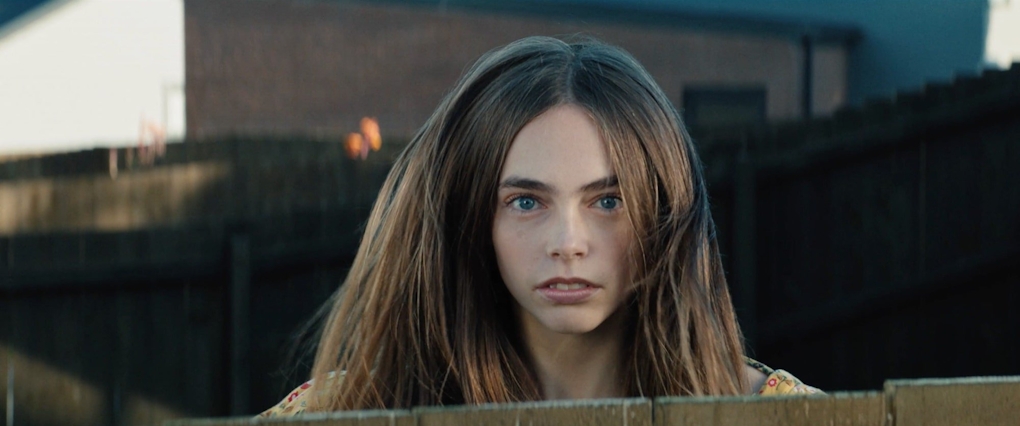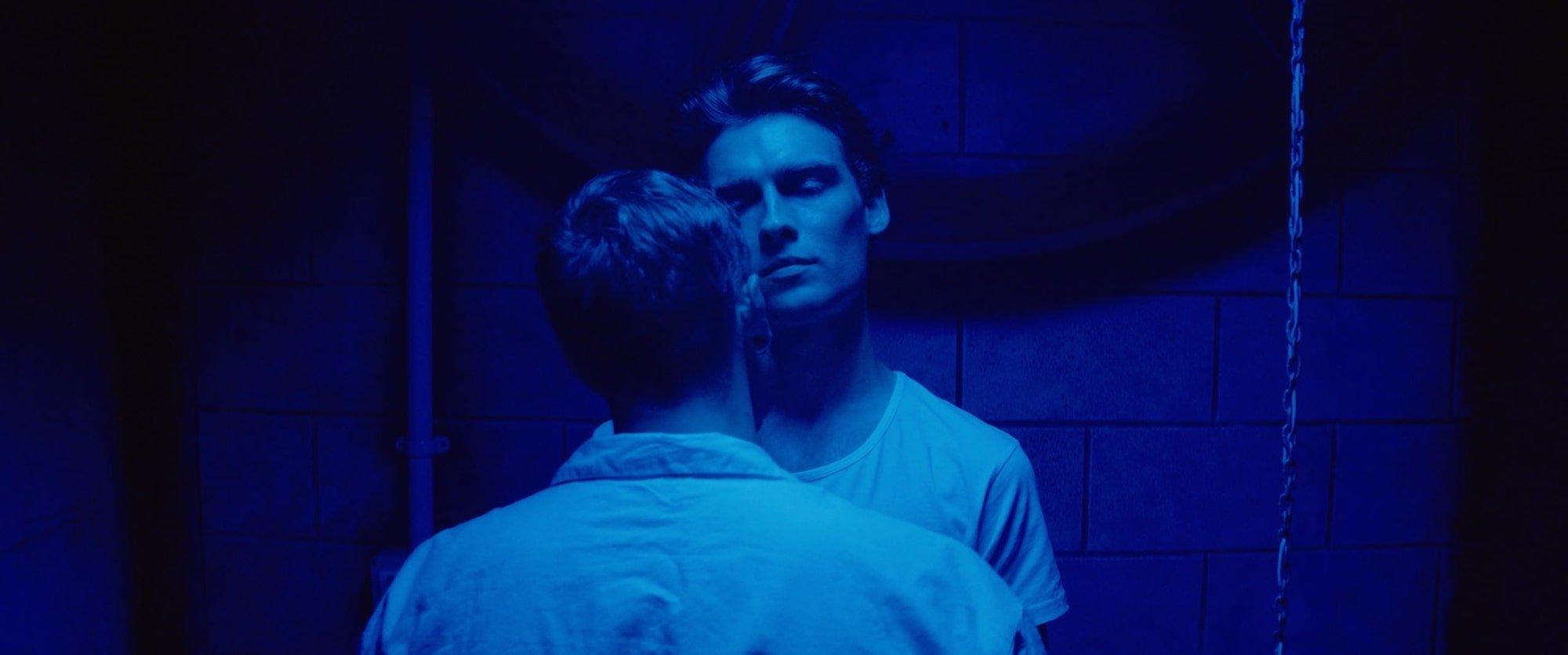Alex Plumb is a moving image artist and filmmaker of Pākeha and Bolivian whakapapa based in Tāmaki Makaurau. His filmic practice exists seamlessly within both fine art and cinema contexts, having exhibited at Sanderson Contemporary and at Film Festivals in Spain, UK and Aotearoa. Through his works we are invited to domestic, club, and bourgeois worlds that at first appear ordinary, but which become increasingly strange and surreal. From my first watch of Plumb’s work I sensed a feeling of unease, as if everything were on the brink of collapse. What is it that pervades these worlds and creates such disquiet? What is hidden amongst the quiet streets of these domestic lives to threaten collapse? What escape is sought under the flashing lights of the club?
In earlier moving-image works such as Elena (2018) and Rosario (2017), there is a distinct lack of dialogue. Instead, Plumb gives us his distinct visual language, atmosphere, and our own psyche from which to deduce meaning.
The opening shot of Rosario situates us on an escalator, moving between floors of a shopping mall. Mirrored surfaces abound in the film frame; depending on where we look, we appear to be ascending, elsewhere, descending. Everywhere we look, we see another place.
Alex Plumb, Rosario (2017)
José Esteban Muñoz, an influential queer theorist, writes in Cruising Utopia: The Then and There of Queer Futurity (2009) how we must not settle for the here and now, rather we must imagine a then and there. Plumb’s shots on the escalator visualise this duality, we are both on the escalator and in the space we see reflected.1
Rosario examines the differences and similarities between tradition and modernity; the elaborate clothing of a traditional Madonna sculpture contrasts with the eccentricities of contemporary urban youth. Plumb began his career as a photographer, and here the scenes are correspondingly still. Likewise, the camera rarely moves. Yet, there is a certain theatricality, the characters of Plumb’s world occupied with their strange stasis and unnerving gaze. The shots—of a drag queen staring down the lens, a woman smoking in a courtyard, an elderly woman rocking in a chair—all give us space to wonder who these characters are. Plumb’s works are an opportunity to revel in the uncertainty of who we’re looking at—and who is looking back at us.
In Plumb’s domestic scenes unremarkable sounds become exaggerated so as to be overwhelming; whether the running of a tap or the static of a radio searching for a clean signal. Again, the characters have no dialogue. Instead, we are lead through various shots of bathrooms, living rooms and cars with an ever-changing sonic attentiveness. Short musical refrains come and go, appearing initially as being dubbed over the images, until their revelation as the music of a television show one of the characters is watching. There are sounds with no visual cue, like that of a dog barking, which help to build and expand the filmic world. While the shots feel constructed and bound by what they choose to reveal, these sounds also allow the film space to continue beyond the edge of the frame.
Writing in Acoustic Territories: Sound Culture and Everyday Life (2010), Brandon LaBelle describes sound as promiscuous; “It exists as a network that teaches us how to belong, to find place, to attune to others, as well as how not to belong, to drift, to figure acts of dislocation, and to dwell within experiences of rupture.”2
Likewise, Plumb uses sound to construct the ‘reality’ of the film, combining a catalogue of sounds from the shooting location with non-diegetic sounds. He also frequently collaborates with composer Claire Cowan to devise luscious scores that assist the emotional geography of the films, describing moments of tension or lust through warm bass tones and orchestral strings.
LaBelle’s idea of sonic rupture is also present in Plumb’s imagery. In the opening shot of Elena, a woman, played by Plumb’s grandmother, lies in a bed of begonias wearing a fluffy baby pink top. She gazes lovingly into the camera, while on the soundtrack, we hear gauzy music reminiscent of a daytime soap opera. The shot then cuts to the same woman sitting in a dimly—lit domestic living room. Here, the light of the television she watches casts her in a grey light. Was it all a daydream?
This question keeps coming back to me when watching Alex’s work, particularly in his 2019 short-film Golden Boy, in which the surreality of his practice comes to the fore. Focused on a young man with a desire to be noticed, Golden Boy follows David over one day and night, from working an opulent party to indulging in a hedonistic club experience. In an early sequence, David stands in the kitchen pouring himself a glass of water. He looks up to see the neighbour jumping on a trampoline, her head appearing briefly above the fence line before disappearing back down again. David’s actions take place in real-time, the girl’s movement, however, is slowed, her hair floating in surreal time. Here Plumb uses cinema as a tool for creating and inhabiting new perspectives and psychological space. By manipulating footage of ‘a moment’ we experience it anew. By editing these different experiences of time together he creates a world made multiple.

Alex Plumb, Golden Boy (2019)
Plumb’s skill in creating particular atmospheres extends to his ability to suddenly change moods. One scene in Golden Boy opens with a shot of David waiting at a bus stop. Behind David is a fence covered in images of psychedelic mushrooms. For a few moments we inhabit David’s perspective, eyeing two sweat—soaked men across the road, our eyes travelling across their faces, down their chests and across their thighs. We get a last look at David standing alone beneath cloudy skies before a truck drives through the scene, and Plumb abruptly cuts to a young circus-like performer blowing glitter to the lens, and us. Garden ornaments of mushrooms, like those from the previous shot, stand behind her. Sharp cuts like this happen frequently in Golden Boy. The ‘world’ of a scene is established only so it can be brought down, distorted, and confused.
This is arguably the essence of the surreal, when fact and fantasy combine to present a new or changed sense of what reality can be. Nora N. Khan similarly states that “all visions of the future are stories about the present”3. Plumb doesn’t necessarily make films about the future, but his visions of the present are mutable ones, where everything is more than what it seems.
Alex Plumb, Golden Boy (2019)
The cinematography in Golden Boy amplifies the unsettling feeling characteristic of Plumb’s films, slow zoom shots keeping rapt attention on the filmic world as well as producing a sense of continuity between scenes. The constant movement draws us ever further in, travelling towards an unknown destination.
In one of Golden Boy’s many glossy scenes we see David enter a dark club. We are introduced to the scene through the sound of his footfall, his walking turning into the heavy booming bass of the club. There is an undeniable drama to this, which I love; the effect being to shift character and audience into a whole new space where the experience becomes confused by darkness and flashing lights. Muñoz writes that the queer club accommodates “an exchange and alteration of kinaesthetic experience through which we become, in a sense, less like ourselves and more like each other.”4 This is not to say the club is a homogenising space, but rather it’s a space for collective intimacies, rhythms, and movements. In the loud, darkened club, communications are made with bodies rather than voices.
Throughout his films Alex Plumb draws us in to worlds both real and surreal. From the snapshots of Elena and Rosario to the more narrative based Golden Boy, he gives us glimpses into who the characters are that populate these worlds. Not one to reveal too much, he keeps us curious and gives us time to inhabit and observe, time to stare down the lens at characters so intently looking back. In these moments I find I am hyper-aware of myself and my body, like staring into your own eyes for so long you start to see yourself as someone else. Throughout his practice this sense of unease prevails. As we search for answers, it never quite dissipates, finding only ever-more questions. Like the opening shot from Rosario on the mirrored escalator, his films allow us to inhabit the multiple, to be in both the real and surreal, to be both here and there.
Fred Small is an artist exploring themes of technological change, queerness, post-humanism and landscape in an installation-based practice.
